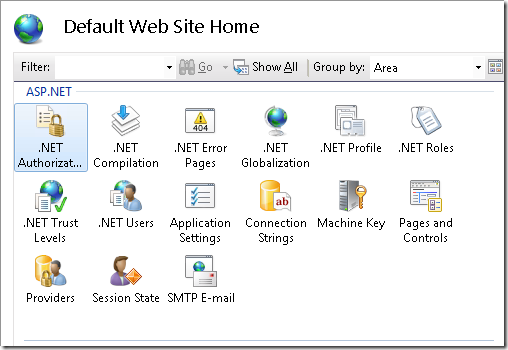Managing ASP.NET Configuration Settings using IIS Manager
Today somebody asked a question about how to manage some ASP.NET configuration settings such as changing the trust level of the application and adding a few application settings and changing compilation settings to debug. I thought it would be trivial to search the web for an article or something that would show the features we added in IIS 7.0 to manage those, but to my surprise I was not able to find anything that would clearly show it, so I decided to write this pretty quickly for anyone that is not aware.
With the release of IIS 7.0 (included in Windows Vista and Windows Server 2008), and of course included in IIS 7.5 (Windows 7 and Windows Server 2008 R2) we added a set of features for managing some of the configuration of common ASP.NET features inside the same IIS Manager. Those features include:
- .NET Authorization Rules 1 – To manage the authorization rules for ASP.NET, this is particularly useful when using Classic Mode. This UI basically is to manage the system.web/authorization section in a graphical way.
- .NET Compilation – This exposes the settings used by the ASP.NET compilation engine, such as list of assemblies, Debug settings, VB settings (Option Strict, Option Explicit), Temp directory, etc. This UI saves all the settings in the system.web/compilation section.
- .NET Error Pages 1 – Allows you to manage the ASP.NET custom errors, exposing the system.web/customErrors.
- .NET Globalization – Allows you to manage the globalization settings such as file encoding, ui culture, etc. This modifies the section system.web/globalization
- .NET Providers 2 – Allows you to manage the different provider configuration for the ASP.NET providers, such as Roles, Membership and Profile. (system.web/membership, system.web/profile, system.web/roleManager, etc).
- .NET Users, .NET Roles and .NET Profile 2 – Configure options that track settings for ASP.NET applications. All these features uses the ASP.NET runtime configuration to allow you to manage their settings, such as adding users, roles and profile settings. (What this post is about). These does not modify configuration but instead they use the Provider configured (such as SqlMembershipProvider, SqlRoleProvider, WindowsTokenRoleProvider, etc)
- .NET Trust Levels, allows you to configure the security trust level policy for the application. Modifies system.web/trust section.
- Application Settings – Allows you to manage the name/value pair stored in the .NET appSettings section.
- Connection Strings – Configures the database connection strings that can be used by ASP.NET applications. Manages the connectionStrings section.
- Machine Key – Allows you to modify the machine key and other related settings stored in system.web/machineKey section.
- Pages and Controls – Allows you to modify settings from the system.web/pages section, such as Base class, Namespaces, and Controls registered.
- Session State – Allows you to configure the session state settings such as connection string, cookie configuration and other configuration included in system.web/sessionState.
- SMTP E-mail – Configure the SMTP settings such as Server, Delivery mode, or Pickup directory, included in system.net/mailSettings/smtp section.
1 – These features are included in Windows 7 and Windows Server 2008 R2, but can be installed for Windows Vista and Windows Server 2008 when downloading the Administration Pack for IIS7.
2 – Note, these features require hosting the ASP.NET runtime and due to technical limitations only application pools configure to run using .NET Version 2.0 will show these features. This means that if you configure your application pool to run .NET 4.0 (in IIS 7.0 and IIS 7.5) you will not see those features. As a workaround you could temporarily change the application pool to run in 2.0, make your changes and switch it back to 4.0 (of course, not recommended for production environments).
These features are not meant to expose all the settings included in ASP.NET, and they only include configuration settings up to .NET 2.0. I should also add that IIS includes a generic configuration editor that allows you to manage a lot more configuration settings from ASP.NET, IIS, and more, in the image below you can see a lot more sections like webParts, trace, siteMap, and others:
The best thing is that you can apply the changes immediately or you can also make changes and just generate the code to automate them later using code, command line or scripts them using Javascript, Managed code, or AppCmd.exe.


